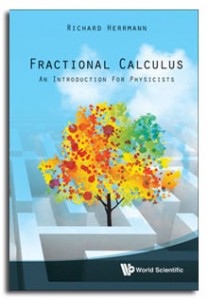
OUT OF PRINT
From the cover:
The book presents a concise introduction to the basic methods and strategies in fractional calculus and enables the reader to catch up with the state of the art in this field as well as to participate and contribute in the development of this exciting research area.
The contents are devoted to the application of fractional calculus to physical problems. The fractional concept is applied to subjects in classical mechanics, group theory, quantum mechanics, nuclear physics, hadron spectroscopy and quantum field theory and it will surprise the reader with new intriguing insights.
This new, extended edition now also covers additional chapters about image processing, folded potentials in cluster physics, infrared spectroscopy and local aspects of fractional calculus. A new feature is exercises with elaborated solutions, which significantly supports a deeper understanding of general aspects of the theory. As a result, this book should also be useful as a supporting medium for teachers and courses devoted to this subject.
Fractional Calculus – An Introduction for Physicists (2nd revised and extended Edition)
by Richard Herrmann,
World Scientific Publishing, Singapore, March 2014, 500 pp, 6 x 9 in.
ISBN: 978-9814551076
Order information at World Scientific Publ.:
additional material: Front matter (Contents etc.) , Chapter 1 (Introduction) , Index
preview: amazon look inside
buy online: amazon.com.au, amazon.br, amazon.ca, amazon.cn, amazon.com, amazon.co.uk, amazon.de, amazon.es, amazon.fr, amazon.in, amazon.it, amazon.jp, amazon.mx, amazon.nl, Barnes & Noble, BAM!(USA), Blackwell’s(UK), booktopia(AU), fishpond(AU), powell’s(USA), ….
reviews:
” …a popular book on fractional calculus, which has proven useful to many new researchers in the field. …A very welcome new feature in the second edition is the inclusion of exercises at the end of every chapter, with detailed solutions in the back of the book. This book is specifically aimed at physicists, although many of my colleagues outside physics have also found it useful. …The book takes a practical approach, which will be especially appealing to those accustomed to thinking about modeling in terms of differential equations and transforms.”
M. M. Meerschaert, Statistics and Probability Dept. ,
Michigan State University,
.
” …I was pleasantly surprised not only by the amount of material the author masterly presents, but also by the timely inclusion of historical remarks that frame the discussions within aspects that the reader is familiar with…
Richard Herrmann’s Fractional Calculus is a highly recommended book…
J. Rogel-Salazar, School of Physics, Astronomy and Mathematics,
University of Hertfordshire,
.
“… A valuable addition to the second edition is the exercises-solutions section. … The significant change in size between the two editions within a short period indicates the importance of fractional calculus. … The reviewer strongly recommends this book for beginners as well as specialists in the fields of physics, mathematics and complex adaptive systems.”
E. Ahmed, Zentralblatt MATH


